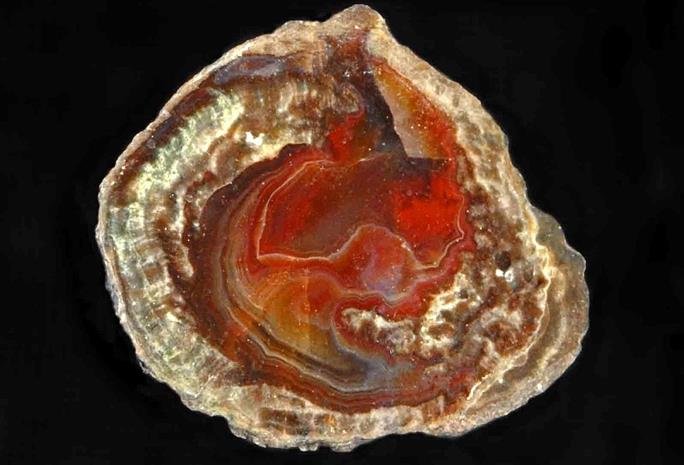Lithophysae (singular lithophysa) are roughly spherical to lenticular-shaped structures with onion-like shells and a hollow center. These structures, which occur primarily in rhyolite lava flows and compacted or welded tuffs, closely resemble spherulites.
Spherulites, however, differ from lithophysae as they lack cavities and occur in glassy volcanic rocks. Additionally, spherulites have dense acicular needle-like crystal masses that radiate from a central point, not concentric shells.
Most lithophysae are the size of a tennis or football, with typical diameters on a decimeter-to-centimeter scale, but some are larger. The larger ones, like those at Silver Cliff, Colorado, USA, have diameters exceeding 12 feet.
The term lithophysa translates to bubble stone, describing these stony structures with cavities or air bubbles, while the formed texture is lithophysal.

How do they form?
The origin or formation of lithophysae remains unknown, but those in rhyolite lava flows are likely the result of the rhythmic exsolution and expansion of volatiles such as magma crystallizers. This process is similar to how vesicles form but occurs in rhythm, resulting in concentric rings.
On the other hand, lithophysae that occur in compacted or welded rhyolite tuffs likely form when exsolving gases collectively collect into pumice fragments.
Related structures
Lithophysae are closely related to and resemble geodes, thundereggs, and vugs, but they differ. What are vugs, thunderheads, and geodes, and how are they different?
1. Geodes
Geodes are hollow or partially filled, roughly round rocky bodies whose voids are lined with mineral crystals. The cavities are commonly lined with jasper, quartz, agate, or opal. Sometimes, the lining minerals have small, well-formed minerals projecting inward into the voids, forming a druzy fabric.
Geodes differ from lithophysae in how they form, where they are, and because they are lined with mineral crystals.
Geodes form from vesicles or voids created when mineral crystals dissolve, are lined with mineral crystals, and occur in volcanic, limestone, shale, or other rocks.
2. Thundereggs
Thundereggs are nearly spherical structures or rock bodies filled with vesicles, common in rhyolite ash layers, lava flow, or tuffs.
They are often filled with agate, jasper, and opal and can have other minerals that are not partially filled, like geodes and form from vesicles.
3. Vugs
Vugs are small to medium, irregular-shaped cavities, often lined with mineral crystals. They can form from vesicles, including in cores of pegmatites, or from rock dissolution. Also, they can form from tectonic activities.
In which rocks do lithophysae occur?
Lithophysae occur in fine-grained or aphanitic volcanic rocks like rhyolite lava flows and compacted tuff. Also, they can occur in glassy silica-rich rocks like obsidian.
In rhyolite lava flows, lithophysae are hollow, nearly spherical masses measuring a few centimeters with concentric layers of aphanitic materials.
Their concentric shells are often made of aphanitic to microcrystalline quartz and alkali feldspar.
On the other hand, those in welded or compacted tuffs are disc-like shaped and often lack the concentric structures shells.
Furthermore, some lithophysae may contain minerals quartz, topaz, hematite and clinoferrosilite formed from vapor-phase precipitates.
Lastly, these structures can occur with spherulites. A good example is Lipari in Italy and Yellowstone National Park in the USA, occurring in obsidian rocks.
Why are they important?
Collectors highly price Lithophysae. Also, some may contain valuable vapor-phase precipitates like topaz.
